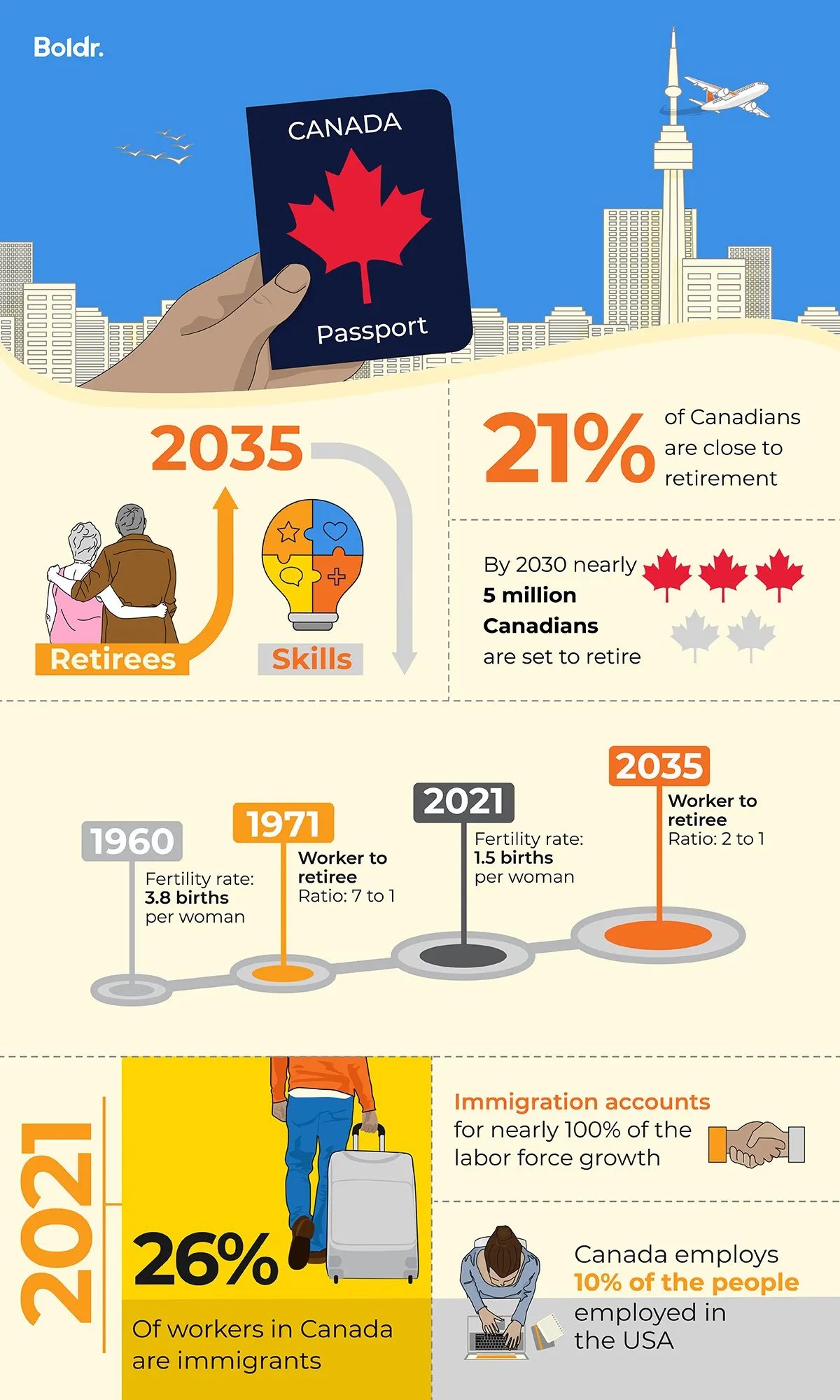Canada is fast becoming a prime outsourcing destination. The Canadian Government has been working tirelessly to simplify the current immigration process for skilled and experienced workers who dream of making Canada their new home. Here are some of the motivating factors driving their need to source skills globally.
High retirement rate
Latest census information reveals that 21% of the population is nearing retirement, which means there will be paucity of skills in coming years. When juxtaposing the rate of retirement to the number of skilled employees, it presents a negative jaws for the future. An estimated 5 million Canadians are set to retire in 2035, reducing the worker to retiree ratio to 2 skilled employees for every 1 retiree. In 1971 this ratio was 7 to 1. That means that there will be fewer skilled employees to support retirees. This is one of the reasons why it is estimated that Canada’s population growth will rely exclusively on immigration by 2030.
Low fertility rate
A greater concern than the aging working population is Canada’s surprisingly low fertility and its troubling rate of decline. In 1960 Canada boasted an average fertility rate of 3.8 births per woman. Over the years this number has gradually decreased to 1.5 births per woman in 2022. Added to the rate of retirement, it has created an under-population spiral that some believe can’t be stopped by immigration alone.

Population vs Land size
Their current population of just under 38 million people and a land area of 3,855 million square miles, makes Canada the fourth largest country in the world, but also one of the most sparsely populated countries in the world. With a population density of only 4 people per square Kilometer (11 per square Mile), it is no surprise that 82% is urban population. Compared to the US, Canada only employs about 10% of the people employed within the States. This alone shows the motivating factors for their current immigration drives.
The current state of immigration in Canada
Canada holds a long history of immigration, simply because the majority of Canadians come from somewhere else. However, at the turn of the century, it became clear that not enough was being done to encourage worldwide talent to immigrate to Canada. Before the pandemic-induced lockdowns froze international travel, the Canadian Government was making hasty moves to market the country as a talent destination for Millennials or Gen Z workers, and to expedite their visa application processes.
In an effort to recover from the economic blows dealt by the pandemic, Canada has since made immigration even easier for hopeful candidates. As a result, they welcomed 401,000 new permanent residents in 2021, which is the most newcomers to the country in Canadian history, surpassing the previous record year of since 1913. Immigration numbers for 2022 are set to top even that. The Government of Canada rolled out the Immigration Levels Plan in February 2022, which seeks to further increase immigration targets from 2022 to 2024.
Immigrants from the United Kingdom are by far the largest foreign-born group in Canada, but they only amount to 1 in every 11 immigrants. This means that the immigrant population of Canada is clearly not dominated by any single group, unlike in Australia and the United States, thereby accentuating the country’s multicultural adaptability.
The benefits of healthy immigration figures
As a country, Canada’s immigration system faces similar demographic challenges related to aging populations and lower birth rates, which is why they are prepared to compete internationally for young, skilled and mobile workers to grow the working age population in coming years.
Skilled immigrants can supplement employment shortfalls in sectors where their skills are found wanting. One such example is the Canadian nonprofit sector that has been chronically understaffed since the early 2000’s. The health-care, information technology and agricultural industries are reliant on new talent to maintain supply chains, which essentially improves businesses across the board.
At present, 26% of workers in Canada are immigrants, with immigration accounting for almost 100% of Canada’s labor force growth. In health-care alone, immigrants make up 37% of pharmacists, 36% of physicians, 39% of dentists, 23% of registered nurses, and 35% of nurse aides and related occupations.
Outsourcing in Canada
While many countries are facing a brain drain, Canada has been one of the few countries to show brain gain. Since the Canadian Government has made changes to address the concerns mentioned above, there has been an explosion in the country’s Information & Communications Technology (ICT) skills, especially in the city of Toronto.
In 2019 Toronto was rated as North America’s fastest growing tech market, in part because tech jobs are less costly in Canada than in San Francisco, New York, or Seattle, but also because there was a demand for tech skills in the city which could only be obtained through immigration. This is evidenced by the fact that, for the year of assessment, there were 57,000 more tech jobs created than there were tech graduates.
The tech wave has systematically spread across the country. As a result, nearly 10% of Ottawa’s workforce has found placement in the tech sector, with Toronto, Hamilton, and the Waterloo region following similar trends. This high-tech employment concentration makes these Canadian cities ripe for outsourcing hubs, which will, as a natural spinoff, contribute largely to local employment, skills development and deliberate immigration of specific skill set to supplement growth strategies. The fact that tech giants like IBM, Bell, Google, Shopify, and Microsoft already have a footprint in Canada, makes it a magnet for global talent.
Boldr has expanded their operation to Canada because we want to offer our clients a nearshore solution through ethical outsourcing. We are excited to build immigration pathways for our teams, while providing access to skills that might be in short supply. Through our B-Corp certification and our impact-driven Theory of Change, Boldr is mandated to form part of community upliftment initiatives within the countries we operate.
James Fouche is a Content Writer at Boldr, an author and a columnist. He is passionate about sharing his love of reading and writing with others.


